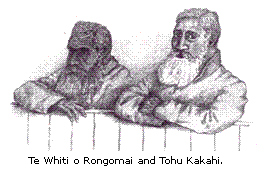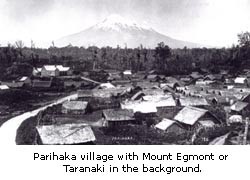Section 4 : What happened after the Treaty was signed?
The Government did not do what it said it would do in the Treaty of Waitangi, which was to let Māori own and control their lands and their lives.
Case Study: Taranaki
Before the Treaty was signed, Māori children in Taranaki lived with their whānau and hapu in their kainga on their land, which was owned by the whole tribe.
War
But a few years after the Treaty was signed, the Government wanted a lot more of their land for British settler families to live on. There was a long war between the Government's army and Taranaki hapu, who wanted to keep their land. It was a very frightening time for the children because there was so much violence and they were always worried about their homes and their families. Many of the adults in their families were killed and some children were killed too. Many of their homes and food gardens were destroyed.
Confiscation
The Government wanted to punish those Taranaki hapu who had fought back against the army. The Government decided to confiscate the land belonging to those hapu. But the Government took far more land than it said it would take. It said that it would give some of it back so that the Māori families would have somewhere to live. But it didn't give any land back for more than 10 years, and even then it did not return anywhere near as much land as it said it would.
Changing the Land-owning Rules

When the Government did return some of the land to Taranaki people, it did not return it to the whole hapu. Instead, it divided it up and made only a few members of the hapu the owners of the land. This caused enormous problems between the families whose names had been written down as owners and the families that were not named.
Nowhere to Live
No land at all was returned to some Taranaki hapu. The families had to live somewhere, so they lived on the land that was once theirs but now belonged to the Government. No one else was living on the land because the Government had not sold the land to settlers as it had said it would.
The End of the Battle
Titokowaru of Ngati Ruanui was a great leader of the Taranaki people. He tried for many years to keep peace between Taranaki hapu and the Government, but the Government kept confiscating more and more Taranaki land. As a last resort, Titokowaru travelled with his people through the war area and cleared it of all soldiers and settlers. After this, the Government was angry and would not meet with those Taranaki Māori leaders who wanted to talk and sort things out.
Parihaka: Peaceful Protest

At this time, a large group of families were living in a community called Parihaka. There were two spiritual leaders, Te Whiti o Rongomai and Tohu Kakahi, who did not believe in violence. They thought it was wrong to fight and much better to solve problems by talking. All the people at Parihaka agreed with this. So, instead of fighting the Government for not returning their land, they started to plough the land that was actually theirs, but now had settler families living on it. This is called 'peaceful protest'. Four hundred ploughmen were arrested and put into jail. They did not fight back when they were arrested.
The army then took over the remaining hapu land. Some of this land had gardens that fed whole communities and they needed these gardens to survive. When the army broke the garden fences, Maori simply put them up again. They did not fight the army. The army tore fences down again and Maori put them up again. Two hundred Taranaki fencers were put in jails with the ploughmen.
During this time, the Government made new laws that said it could put Māori in jail without trial. This meant that Māori did not go to court first to find out whether or not they were guilty of breaking a law.
The Government did not like the people at Parihaka controlling their own lives. It claimed that the people at Parihaka were preparing for war against the Government. So it sent a huge army into the peaceful settlement and destroyed it. Tohu and Te Whiti were charged with plotting against the Government and jailed. Tohu and Te Whiti had only one question for the Government. They asked about the land that was supposed to have been returned 19 years before.
During the trial, or court case, of Tohu and Te Whiti, it seemed that they might not have done anything wrong and that the army was in the wrong. So the Government quickly made a new law which said that whatever soldiers did at Parihaka was legal. The trial of Tohu and Te Whiti was stopped. It was decided that they were guilty without having a court case.
After this, the Government gave back some of the land they had been promising for such a long time. But there was a catch. Settler families were living on quite a lot of it and were allowed to live there for as long as they wanted to. The Government badly interfered with Taranaki iwi. It made it impossible for the hapu to make enough money to live a good life. The Government made laws which stopped them from living on and taking care of their land in the ways that they always had done. The Government stopped Taranaki hapu from controlling their lives. It destroyed their communities.
The Situation Today
Today, Taranaki iwi have still not received the land that was promised after the war. Some Taranaki women still wear the raukura in their hair, a sign of peace that originates from the Parihaka peaceful protests. The people still have not recovered the quality of life they had before the Government destroyed their communities. The families have not forgotten all the terrible things that happened to their people. Parents told their children what happened, and when those children grew up, they told their children, and so on till the present day.
What Happened After the Treaty: Questions and Activities
This page was last updated: